HCI Research: A Literature Review of AI and Intelligent Interfaces
VerifiedAdded on 2023/06/07
|12
|3382
|453
Literature Review
AI Summary
This literature review delves into the advancements in artificial intelligence (AI) and intelligent user interfaces, highlighting their impact across various sectors. It discusses the role of AI in enhancing computer capabilities, enabling independent and intelligent decision-making, and creating intelligent computerized systems that mimic human thought processes. The review examines peer production models in urban and rural contexts, the use of touch screens for music creation, and the application of Clinical Decision Supporting Tools (DSTs) in healthcare. It also explores smart energy systems, intelligent conversational agents, and the integration of digital and physical environments through intelligent agents. Furthermore, the review introduces the Compressed-Pattern, Robotic Architecture (CoPRA) for smart environments and discusses the detection and response to mind wandering (MW) through intelligent interfaces. The analysis of real-time strategy games like StarCraft as AI research platforms is also covered, offering a comprehensive overview of the current state and future prospects of AI and intelligent interfaces.
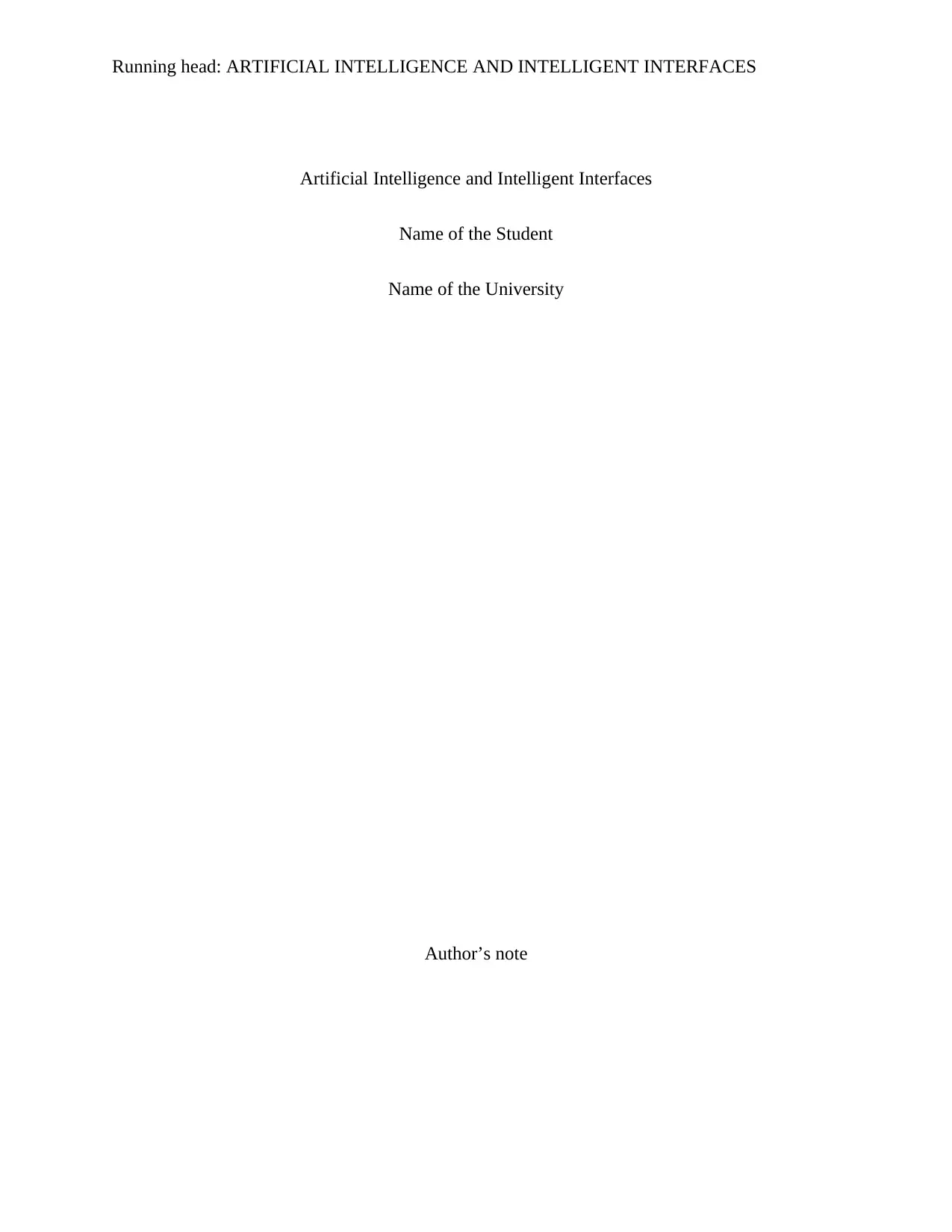
Running head: ARTIFICIAL INTELLIGENCE AND INTELLIGENT INTERFACES
Artificial Intelligence and Intelligent Interfaces
Name of the Student
Name of the University
Author’s note
Artificial Intelligence and Intelligent Interfaces
Name of the Student
Name of the University
Author’s note
Paraphrase This Document
Need a fresh take? Get an instant paraphrase of this document with our AI Paraphraser
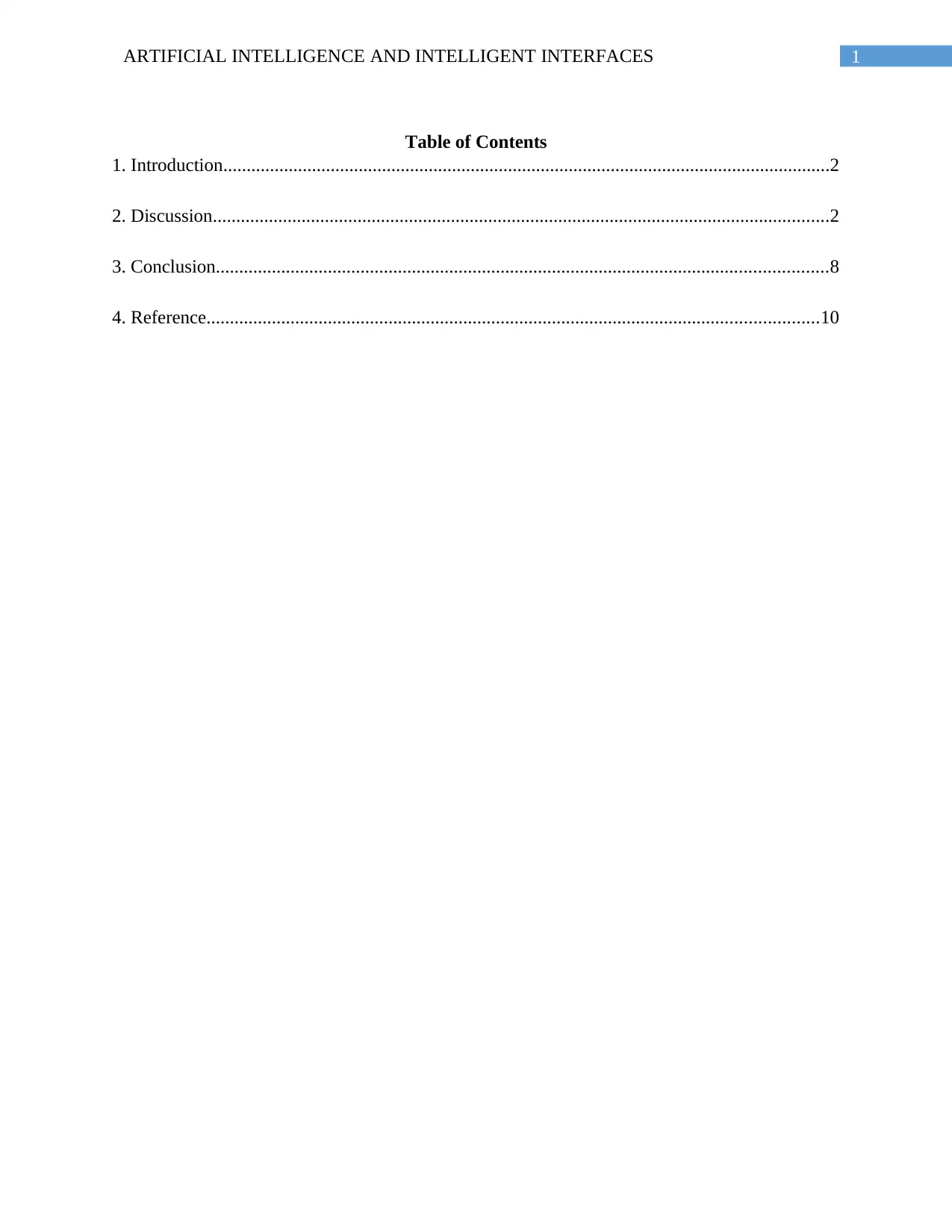
1ARTIFICIAL INTELLIGENCE AND INTELLIGENT INTERFACES
Table of Contents
1. Introduction..................................................................................................................................2
2. Discussion....................................................................................................................................2
3. Conclusion...................................................................................................................................8
4. Reference...................................................................................................................................10
Table of Contents
1. Introduction..................................................................................................................................2
2. Discussion....................................................................................................................................2
3. Conclusion...................................................................................................................................8
4. Reference...................................................................................................................................10
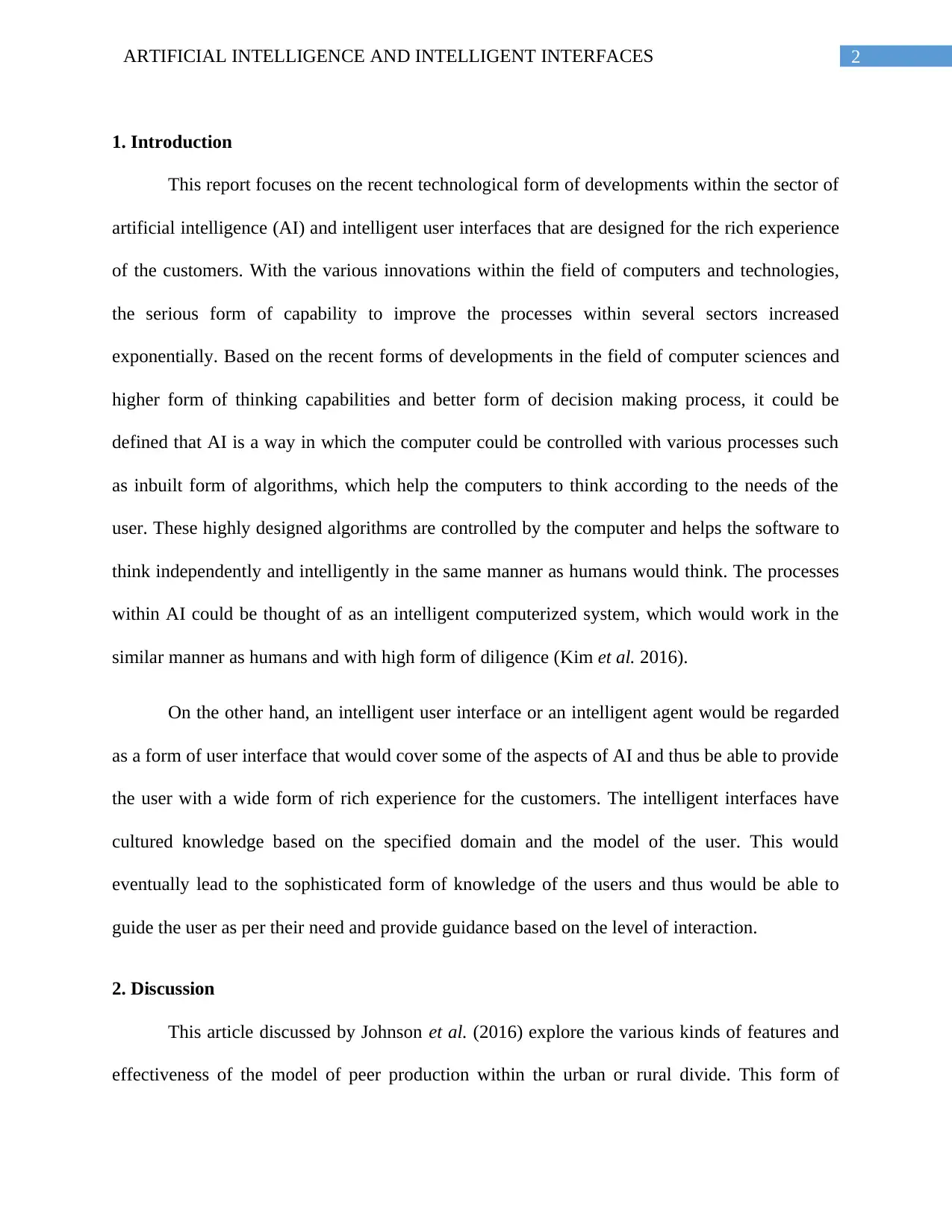
2ARTIFICIAL INTELLIGENCE AND INTELLIGENT INTERFACES
1. Introduction
This report focuses on the recent technological form of developments within the sector of
artificial intelligence (AI) and intelligent user interfaces that are designed for the rich experience
of the customers. With the various innovations within the field of computers and technologies,
the serious form of capability to improve the processes within several sectors increased
exponentially. Based on the recent forms of developments in the field of computer sciences and
higher form of thinking capabilities and better form of decision making process, it could be
defined that AI is a way in which the computer could be controlled with various processes such
as inbuilt form of algorithms, which help the computers to think according to the needs of the
user. These highly designed algorithms are controlled by the computer and helps the software to
think independently and intelligently in the same manner as humans would think. The processes
within AI could be thought of as an intelligent computerized system, which would work in the
similar manner as humans and with high form of diligence (Kim et al. 2016).
On the other hand, an intelligent user interface or an intelligent agent would be regarded
as a form of user interface that would cover some of the aspects of AI and thus be able to provide
the user with a wide form of rich experience for the customers. The intelligent interfaces have
cultured knowledge based on the specified domain and the model of the user. This would
eventually lead to the sophisticated form of knowledge of the users and thus would be able to
guide the user as per their need and provide guidance based on the level of interaction.
2. Discussion
This article discussed by Johnson et al. (2016) explore the various kinds of features and
effectiveness of the model of peer production within the urban or rural divide. This form of
1. Introduction
This report focuses on the recent technological form of developments within the sector of
artificial intelligence (AI) and intelligent user interfaces that are designed for the rich experience
of the customers. With the various innovations within the field of computers and technologies,
the serious form of capability to improve the processes within several sectors increased
exponentially. Based on the recent forms of developments in the field of computer sciences and
higher form of thinking capabilities and better form of decision making process, it could be
defined that AI is a way in which the computer could be controlled with various processes such
as inbuilt form of algorithms, which help the computers to think according to the needs of the
user. These highly designed algorithms are controlled by the computer and helps the software to
think independently and intelligently in the same manner as humans would think. The processes
within AI could be thought of as an intelligent computerized system, which would work in the
similar manner as humans and with high form of diligence (Kim et al. 2016).
On the other hand, an intelligent user interface or an intelligent agent would be regarded
as a form of user interface that would cover some of the aspects of AI and thus be able to provide
the user with a wide form of rich experience for the customers. The intelligent interfaces have
cultured knowledge based on the specified domain and the model of the user. This would
eventually lead to the sophisticated form of knowledge of the users and thus would be able to
guide the user as per their need and provide guidance based on the level of interaction.
2. Discussion
This article discussed by Johnson et al. (2016) explore the various kinds of features and
effectiveness of the model of peer production within the urban or rural divide. This form of
⊘ This is a preview!⊘
Do you want full access?
Subscribe today to unlock all pages.

Trusted by 1+ million students worldwide
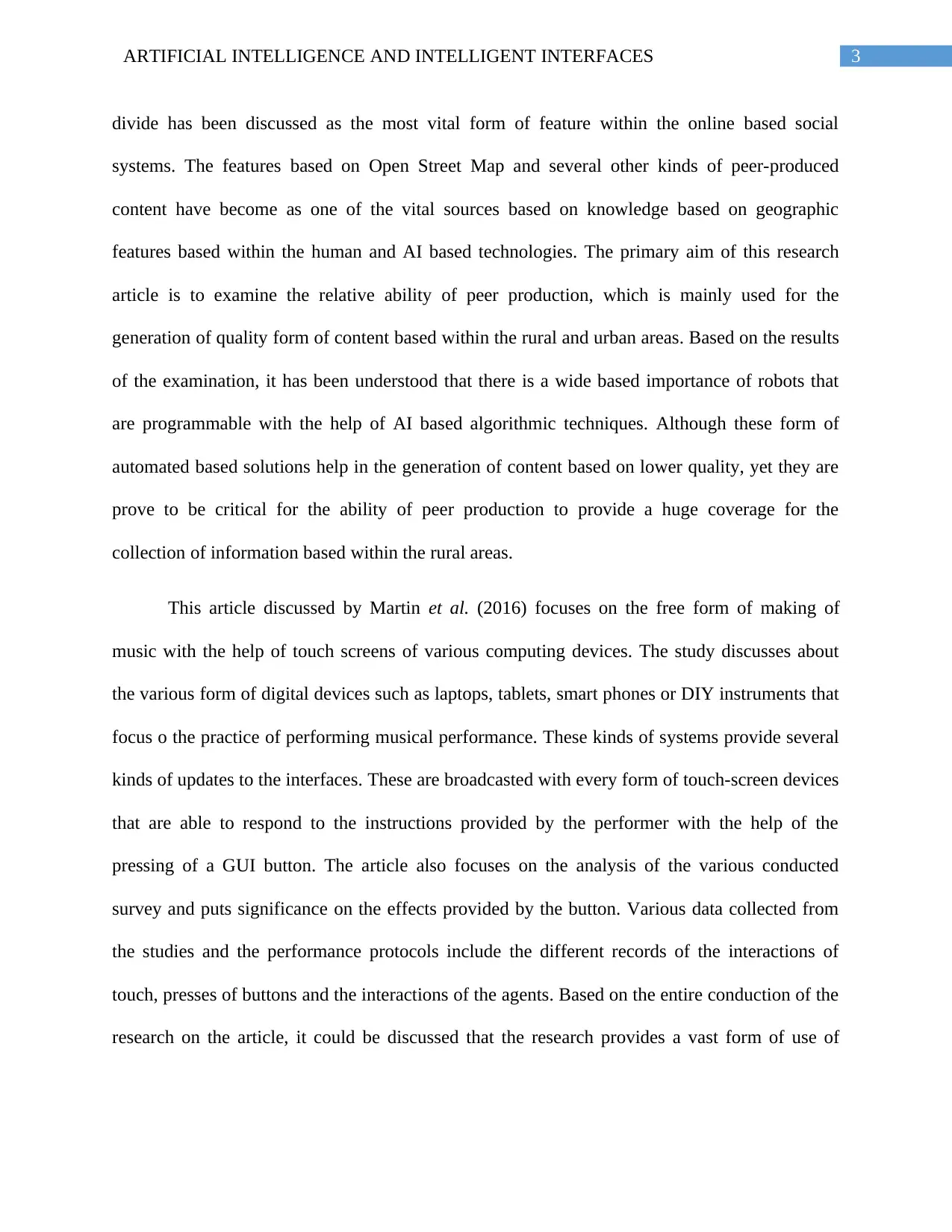
3ARTIFICIAL INTELLIGENCE AND INTELLIGENT INTERFACES
divide has been discussed as the most vital form of feature within the online based social
systems. The features based on Open Street Map and several other kinds of peer-produced
content have become as one of the vital sources based on knowledge based on geographic
features based within the human and AI based technologies. The primary aim of this research
article is to examine the relative ability of peer production, which is mainly used for the
generation of quality form of content based within the rural and urban areas. Based on the results
of the examination, it has been understood that there is a wide based importance of robots that
are programmable with the help of AI based algorithmic techniques. Although these form of
automated based solutions help in the generation of content based on lower quality, yet they are
prove to be critical for the ability of peer production to provide a huge coverage for the
collection of information based within the rural areas.
This article discussed by Martin et al. (2016) focuses on the free form of making of
music with the help of touch screens of various computing devices. The study discusses about
the various form of digital devices such as laptops, tablets, smart phones or DIY instruments that
focus o the practice of performing musical performance. These kinds of systems provide several
kinds of updates to the interfaces. These are broadcasted with every form of touch-screen devices
that are able to respond to the instructions provided by the performer with the help of the
pressing of a GUI button. The article also focuses on the analysis of the various conducted
survey and puts significance on the effects provided by the button. Various data collected from
the studies and the performance protocols include the different records of the interactions of
touch, presses of buttons and the interactions of the agents. Based on the entire conduction of the
research on the article, it could be discussed that the research provides a vast form of use of
divide has been discussed as the most vital form of feature within the online based social
systems. The features based on Open Street Map and several other kinds of peer-produced
content have become as one of the vital sources based on knowledge based on geographic
features based within the human and AI based technologies. The primary aim of this research
article is to examine the relative ability of peer production, which is mainly used for the
generation of quality form of content based within the rural and urban areas. Based on the results
of the examination, it has been understood that there is a wide based importance of robots that
are programmable with the help of AI based algorithmic techniques. Although these form of
automated based solutions help in the generation of content based on lower quality, yet they are
prove to be critical for the ability of peer production to provide a huge coverage for the
collection of information based within the rural areas.
This article discussed by Martin et al. (2016) focuses on the free form of making of
music with the help of touch screens of various computing devices. The study discusses about
the various form of digital devices such as laptops, tablets, smart phones or DIY instruments that
focus o the practice of performing musical performance. These kinds of systems provide several
kinds of updates to the interfaces. These are broadcasted with every form of touch-screen devices
that are able to respond to the instructions provided by the performer with the help of the
pressing of a GUI button. The article also focuses on the analysis of the various conducted
survey and puts significance on the effects provided by the button. Various data collected from
the studies and the performance protocols include the different records of the interactions of
touch, presses of buttons and the interactions of the agents. Based on the entire conduction of the
research on the article, it could be discussed that the research provides a vast form of use of
Paraphrase This Document
Need a fresh take? Get an instant paraphrase of this document with our AI Paraphraser
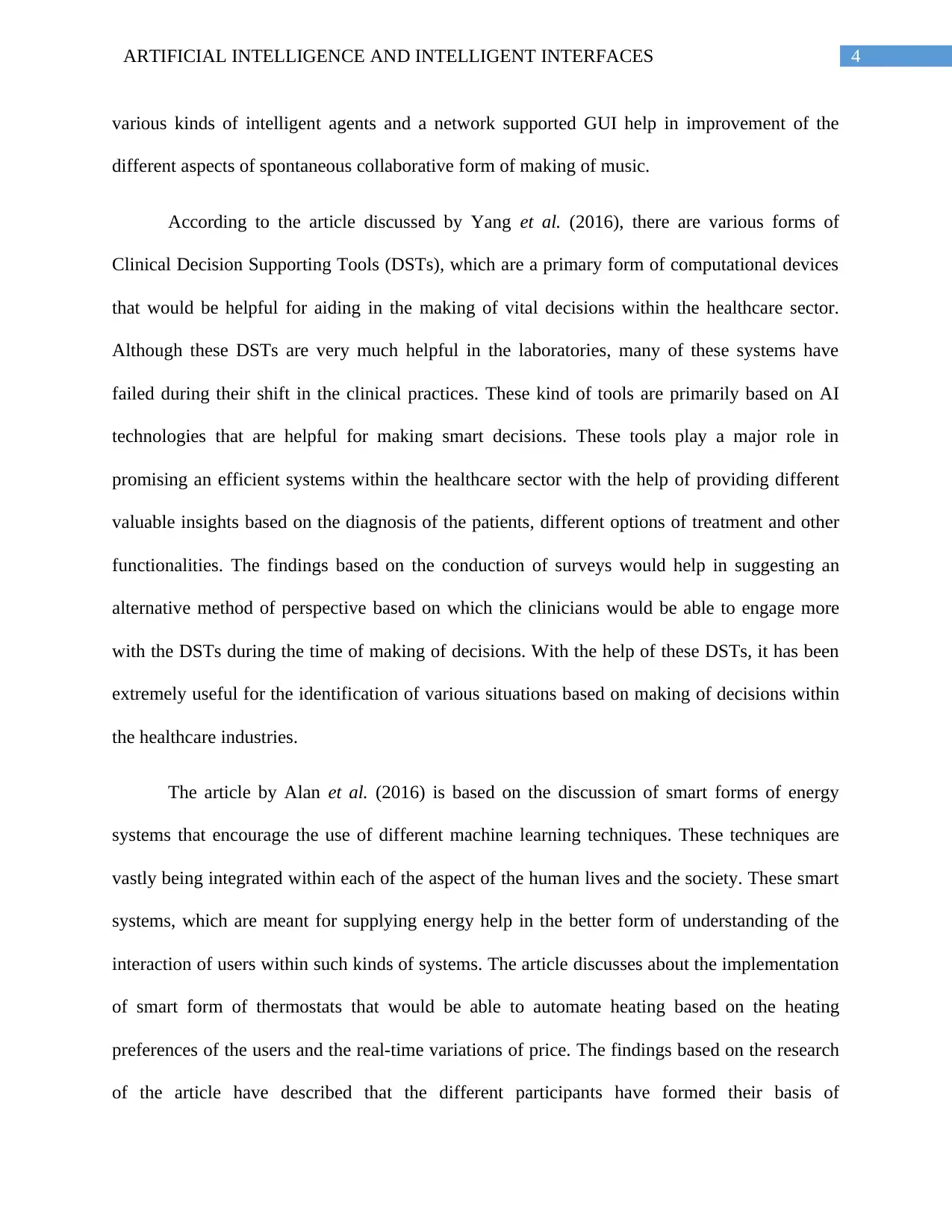
4ARTIFICIAL INTELLIGENCE AND INTELLIGENT INTERFACES
various kinds of intelligent agents and a network supported GUI help in improvement of the
different aspects of spontaneous collaborative form of making of music.
According to the article discussed by Yang et al. (2016), there are various forms of
Clinical Decision Supporting Tools (DSTs), which are a primary form of computational devices
that would be helpful for aiding in the making of vital decisions within the healthcare sector.
Although these DSTs are very much helpful in the laboratories, many of these systems have
failed during their shift in the clinical practices. These kind of tools are primarily based on AI
technologies that are helpful for making smart decisions. These tools play a major role in
promising an efficient systems within the healthcare sector with the help of providing different
valuable insights based on the diagnosis of the patients, different options of treatment and other
functionalities. The findings based on the conduction of surveys would help in suggesting an
alternative method of perspective based on which the clinicians would be able to engage more
with the DSTs during the time of making of decisions. With the help of these DSTs, it has been
extremely useful for the identification of various situations based on making of decisions within
the healthcare industries.
The article by Alan et al. (2016) is based on the discussion of smart forms of energy
systems that encourage the use of different machine learning techniques. These techniques are
vastly being integrated within each of the aspect of the human lives and the society. These smart
systems, which are meant for supplying energy help in the better form of understanding of the
interaction of users within such kinds of systems. The article discusses about the implementation
of smart form of thermostats that would be able to automate heating based on the heating
preferences of the users and the real-time variations of price. The findings based on the research
of the article have described that the different participants have formed their basis of
various kinds of intelligent agents and a network supported GUI help in improvement of the
different aspects of spontaneous collaborative form of making of music.
According to the article discussed by Yang et al. (2016), there are various forms of
Clinical Decision Supporting Tools (DSTs), which are a primary form of computational devices
that would be helpful for aiding in the making of vital decisions within the healthcare sector.
Although these DSTs are very much helpful in the laboratories, many of these systems have
failed during their shift in the clinical practices. These kind of tools are primarily based on AI
technologies that are helpful for making smart decisions. These tools play a major role in
promising an efficient systems within the healthcare sector with the help of providing different
valuable insights based on the diagnosis of the patients, different options of treatment and other
functionalities. The findings based on the conduction of surveys would help in suggesting an
alternative method of perspective based on which the clinicians would be able to engage more
with the DSTs during the time of making of decisions. With the help of these DSTs, it has been
extremely useful for the identification of various situations based on making of decisions within
the healthcare industries.
The article by Alan et al. (2016) is based on the discussion of smart forms of energy
systems that encourage the use of different machine learning techniques. These techniques are
vastly being integrated within each of the aspect of the human lives and the society. These smart
systems, which are meant for supplying energy help in the better form of understanding of the
interaction of users within such kinds of systems. The article discusses about the implementation
of smart form of thermostats that would be able to automate heating based on the heating
preferences of the users and the real-time variations of price. The findings based on the research
of the article have described that the different participants have formed their basis of
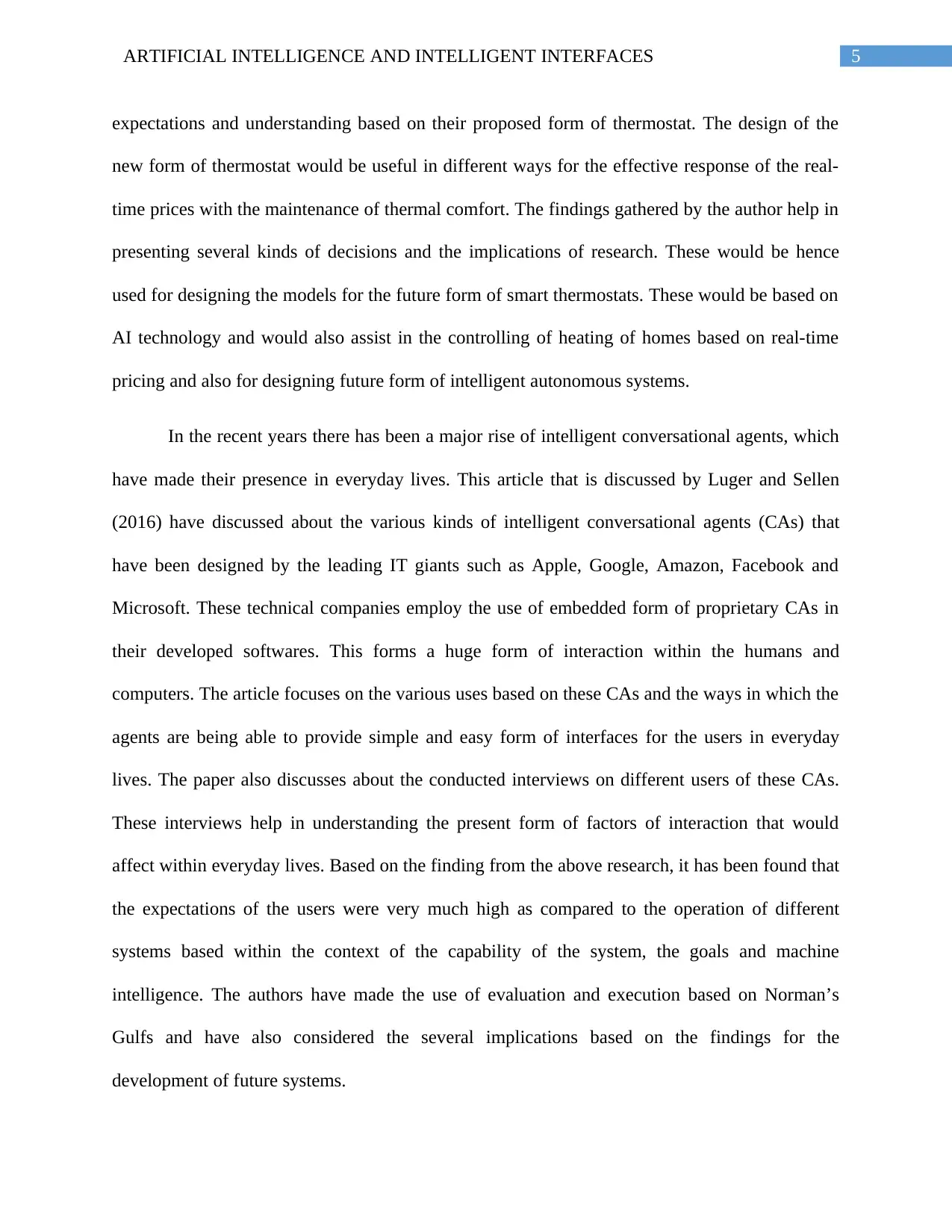
5ARTIFICIAL INTELLIGENCE AND INTELLIGENT INTERFACES
expectations and understanding based on their proposed form of thermostat. The design of the
new form of thermostat would be useful in different ways for the effective response of the real-
time prices with the maintenance of thermal comfort. The findings gathered by the author help in
presenting several kinds of decisions and the implications of research. These would be hence
used for designing the models for the future form of smart thermostats. These would be based on
AI technology and would also assist in the controlling of heating of homes based on real-time
pricing and also for designing future form of intelligent autonomous systems.
In the recent years there has been a major rise of intelligent conversational agents, which
have made their presence in everyday lives. This article that is discussed by Luger and Sellen
(2016) have discussed about the various kinds of intelligent conversational agents (CAs) that
have been designed by the leading IT giants such as Apple, Google, Amazon, Facebook and
Microsoft. These technical companies employ the use of embedded form of proprietary CAs in
their developed softwares. This forms a huge form of interaction within the humans and
computers. The article focuses on the various uses based on these CAs and the ways in which the
agents are being able to provide simple and easy form of interfaces for the users in everyday
lives. The paper also discusses about the conducted interviews on different users of these CAs.
These interviews help in understanding the present form of factors of interaction that would
affect within everyday lives. Based on the finding from the above research, it has been found that
the expectations of the users were very much high as compared to the operation of different
systems based within the context of the capability of the system, the goals and machine
intelligence. The authors have made the use of evaluation and execution based on Norman’s
Gulfs and have also considered the several implications based on the findings for the
development of future systems.
expectations and understanding based on their proposed form of thermostat. The design of the
new form of thermostat would be useful in different ways for the effective response of the real-
time prices with the maintenance of thermal comfort. The findings gathered by the author help in
presenting several kinds of decisions and the implications of research. These would be hence
used for designing the models for the future form of smart thermostats. These would be based on
AI technology and would also assist in the controlling of heating of homes based on real-time
pricing and also for designing future form of intelligent autonomous systems.
In the recent years there has been a major rise of intelligent conversational agents, which
have made their presence in everyday lives. This article that is discussed by Luger and Sellen
(2016) have discussed about the various kinds of intelligent conversational agents (CAs) that
have been designed by the leading IT giants such as Apple, Google, Amazon, Facebook and
Microsoft. These technical companies employ the use of embedded form of proprietary CAs in
their developed softwares. This forms a huge form of interaction within the humans and
computers. The article focuses on the various uses based on these CAs and the ways in which the
agents are being able to provide simple and easy form of interfaces for the users in everyday
lives. The paper also discusses about the conducted interviews on different users of these CAs.
These interviews help in understanding the present form of factors of interaction that would
affect within everyday lives. Based on the finding from the above research, it has been found that
the expectations of the users were very much high as compared to the operation of different
systems based within the context of the capability of the system, the goals and machine
intelligence. The authors have made the use of evaluation and execution based on Norman’s
Gulfs and have also considered the several implications based on the findings for the
development of future systems.
⊘ This is a preview!⊘
Do you want full access?
Subscribe today to unlock all pages.

Trusted by 1+ million students worldwide
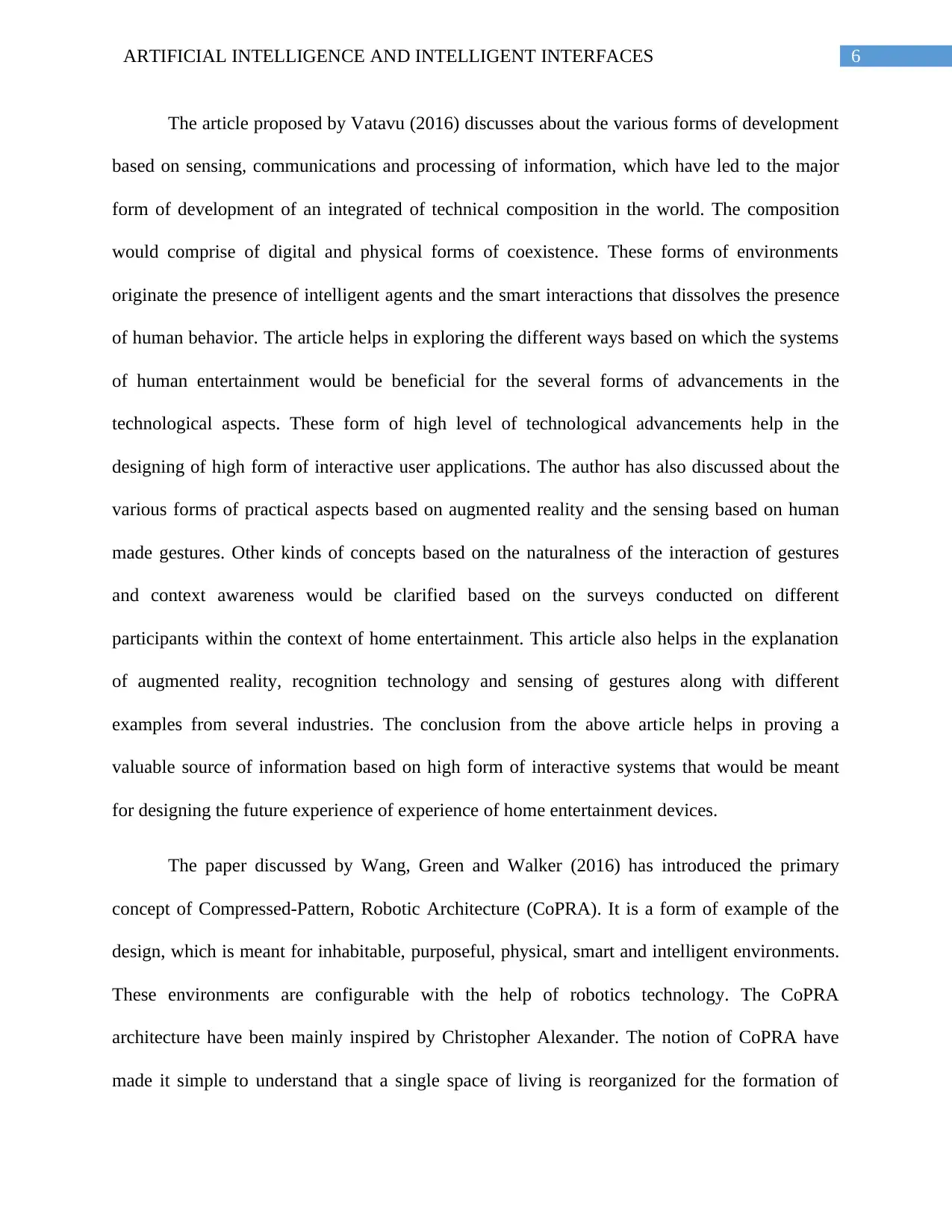
6ARTIFICIAL INTELLIGENCE AND INTELLIGENT INTERFACES
The article proposed by Vatavu (2016) discusses about the various forms of development
based on sensing, communications and processing of information, which have led to the major
form of development of an integrated of technical composition in the world. The composition
would comprise of digital and physical forms of coexistence. These forms of environments
originate the presence of intelligent agents and the smart interactions that dissolves the presence
of human behavior. The article helps in exploring the different ways based on which the systems
of human entertainment would be beneficial for the several forms of advancements in the
technological aspects. These form of high level of technological advancements help in the
designing of high form of interactive user applications. The author has also discussed about the
various forms of practical aspects based on augmented reality and the sensing based on human
made gestures. Other kinds of concepts based on the naturalness of the interaction of gestures
and context awareness would be clarified based on the surveys conducted on different
participants within the context of home entertainment. This article also helps in the explanation
of augmented reality, recognition technology and sensing of gestures along with different
examples from several industries. The conclusion from the above article helps in proving a
valuable source of information based on high form of interactive systems that would be meant
for designing the future experience of experience of home entertainment devices.
The paper discussed by Wang, Green and Walker (2016) has introduced the primary
concept of Compressed-Pattern, Robotic Architecture (CoPRA). It is a form of example of the
design, which is meant for inhabitable, purposeful, physical, smart and intelligent environments.
These environments are configurable with the help of robotics technology. The CoPRA
architecture have been mainly inspired by Christopher Alexander. The notion of CoPRA have
made it simple to understand that a single space of living is reorganized for the formation of
The article proposed by Vatavu (2016) discusses about the various forms of development
based on sensing, communications and processing of information, which have led to the major
form of development of an integrated of technical composition in the world. The composition
would comprise of digital and physical forms of coexistence. These forms of environments
originate the presence of intelligent agents and the smart interactions that dissolves the presence
of human behavior. The article helps in exploring the different ways based on which the systems
of human entertainment would be beneficial for the several forms of advancements in the
technological aspects. These form of high level of technological advancements help in the
designing of high form of interactive user applications. The author has also discussed about the
various forms of practical aspects based on augmented reality and the sensing based on human
made gestures. Other kinds of concepts based on the naturalness of the interaction of gestures
and context awareness would be clarified based on the surveys conducted on different
participants within the context of home entertainment. This article also helps in the explanation
of augmented reality, recognition technology and sensing of gestures along with different
examples from several industries. The conclusion from the above article helps in proving a
valuable source of information based on high form of interactive systems that would be meant
for designing the future experience of experience of home entertainment devices.
The paper discussed by Wang, Green and Walker (2016) has introduced the primary
concept of Compressed-Pattern, Robotic Architecture (CoPRA). It is a form of example of the
design, which is meant for inhabitable, purposeful, physical, smart and intelligent environments.
These environments are configurable with the help of robotics technology. The CoPRA
architecture have been mainly inspired by Christopher Alexander. The notion of CoPRA have
made it simple to understand that a single space of living is reorganized for the formation of
Paraphrase This Document
Need a fresh take? Get an instant paraphrase of this document with our AI Paraphraser
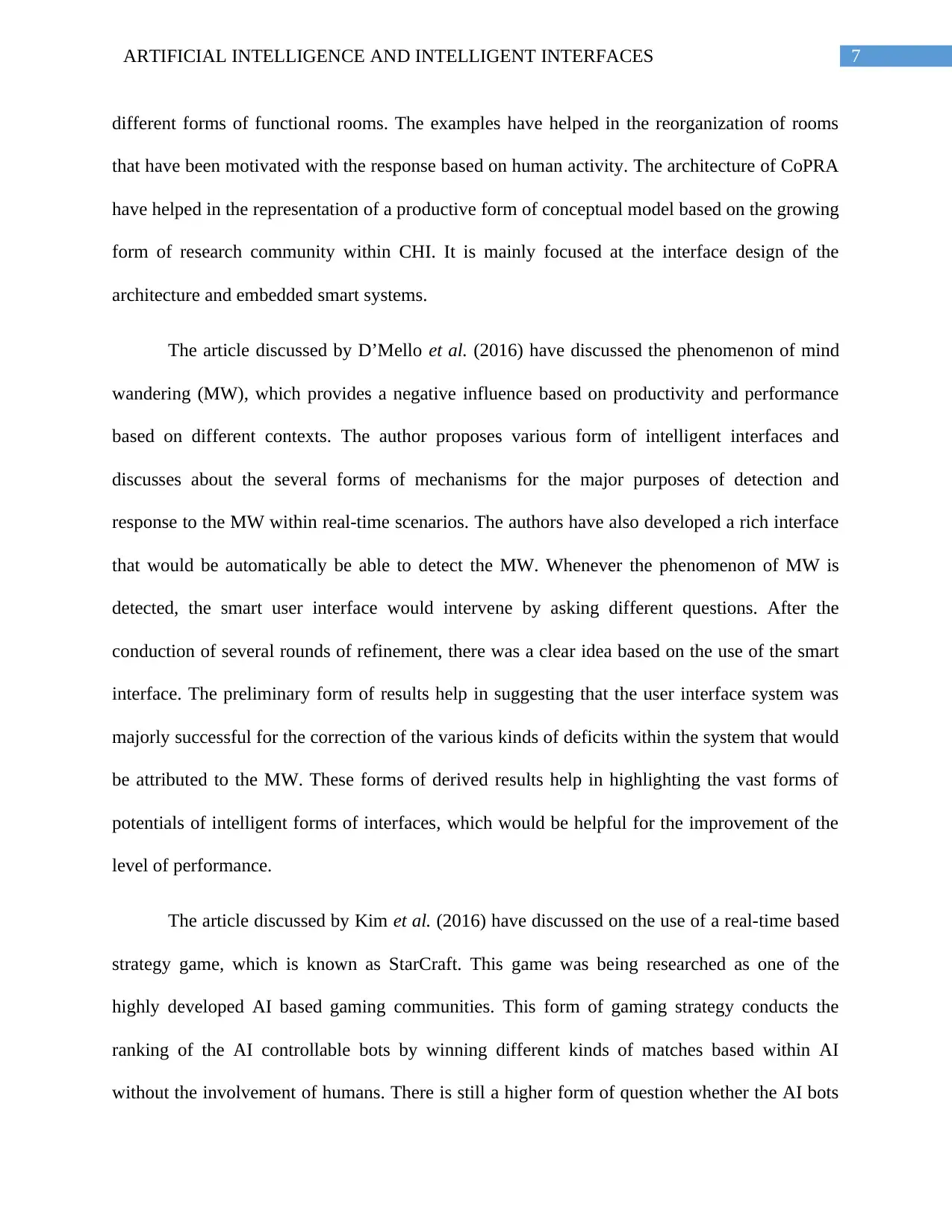
7ARTIFICIAL INTELLIGENCE AND INTELLIGENT INTERFACES
different forms of functional rooms. The examples have helped in the reorganization of rooms
that have been motivated with the response based on human activity. The architecture of CoPRA
have helped in the representation of a productive form of conceptual model based on the growing
form of research community within CHI. It is mainly focused at the interface design of the
architecture and embedded smart systems.
The article discussed by D’Mello et al. (2016) have discussed the phenomenon of mind
wandering (MW), which provides a negative influence based on productivity and performance
based on different contexts. The author proposes various form of intelligent interfaces and
discusses about the several forms of mechanisms for the major purposes of detection and
response to the MW within real-time scenarios. The authors have also developed a rich interface
that would be automatically be able to detect the MW. Whenever the phenomenon of MW is
detected, the smart user interface would intervene by asking different questions. After the
conduction of several rounds of refinement, there was a clear idea based on the use of the smart
interface. The preliminary form of results help in suggesting that the user interface system was
majorly successful for the correction of the various kinds of deficits within the system that would
be attributed to the MW. These forms of derived results help in highlighting the vast forms of
potentials of intelligent forms of interfaces, which would be helpful for the improvement of the
level of performance.
The article discussed by Kim et al. (2016) have discussed on the use of a real-time based
strategy game, which is known as StarCraft. This game was being researched as one of the
highly developed AI based gaming communities. This form of gaming strategy conducts the
ranking of the AI controllable bots by winning different kinds of matches based within AI
without the involvement of humans. There is still a higher form of question whether the AI bots
different forms of functional rooms. The examples have helped in the reorganization of rooms
that have been motivated with the response based on human activity. The architecture of CoPRA
have helped in the representation of a productive form of conceptual model based on the growing
form of research community within CHI. It is mainly focused at the interface design of the
architecture and embedded smart systems.
The article discussed by D’Mello et al. (2016) have discussed the phenomenon of mind
wandering (MW), which provides a negative influence based on productivity and performance
based on different contexts. The author proposes various form of intelligent interfaces and
discusses about the several forms of mechanisms for the major purposes of detection and
response to the MW within real-time scenarios. The authors have also developed a rich interface
that would be automatically be able to detect the MW. Whenever the phenomenon of MW is
detected, the smart user interface would intervene by asking different questions. After the
conduction of several rounds of refinement, there was a clear idea based on the use of the smart
interface. The preliminary form of results help in suggesting that the user interface system was
majorly successful for the correction of the various kinds of deficits within the system that would
be attributed to the MW. These forms of derived results help in highlighting the vast forms of
potentials of intelligent forms of interfaces, which would be helpful for the improvement of the
level of performance.
The article discussed by Kim et al. (2016) have discussed on the use of a real-time based
strategy game, which is known as StarCraft. This game was being researched as one of the
highly developed AI based gaming communities. This form of gaming strategy conducts the
ranking of the AI controllable bots by winning different kinds of matches based within AI
without the involvement of humans. There is still a higher form of question whether the AI bots
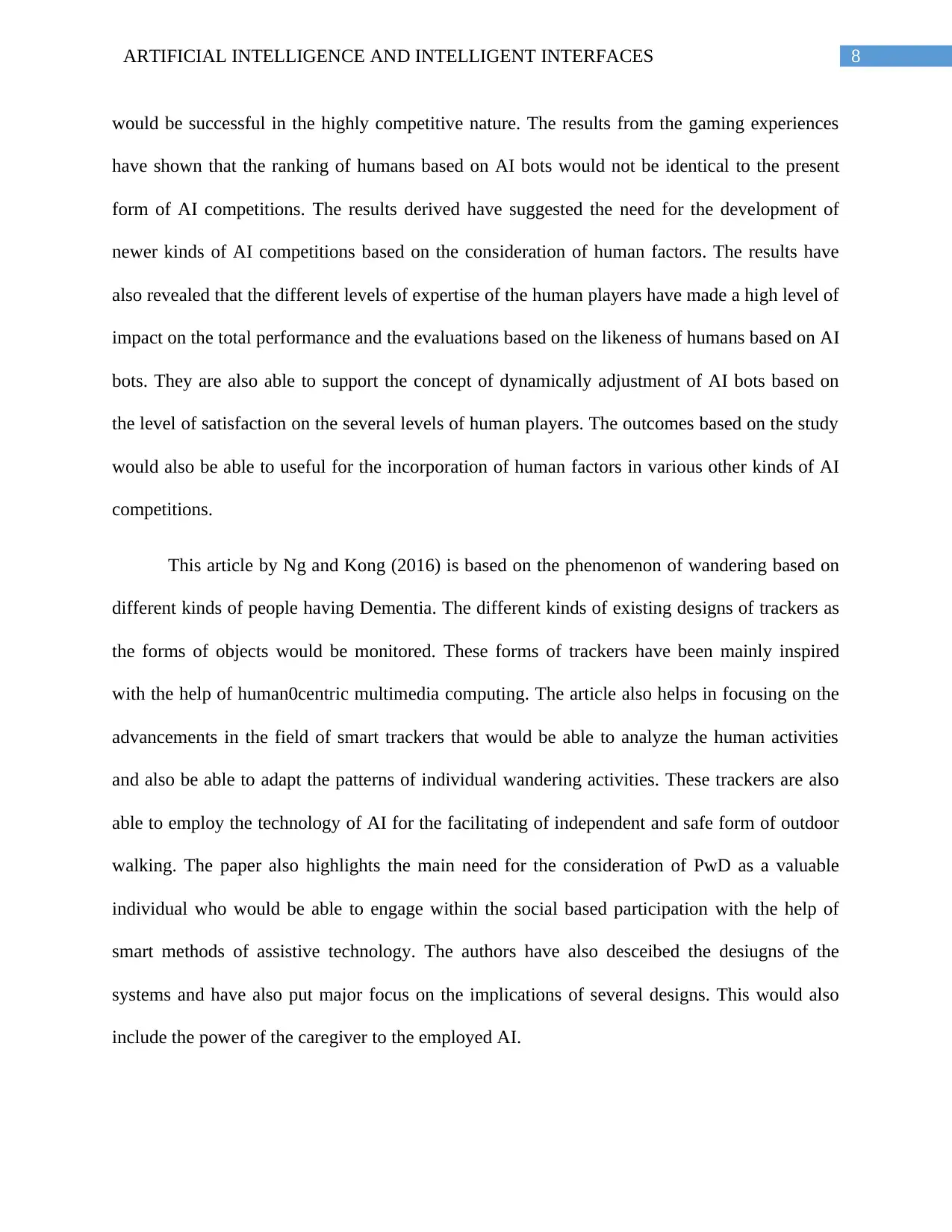
8ARTIFICIAL INTELLIGENCE AND INTELLIGENT INTERFACES
would be successful in the highly competitive nature. The results from the gaming experiences
have shown that the ranking of humans based on AI bots would not be identical to the present
form of AI competitions. The results derived have suggested the need for the development of
newer kinds of AI competitions based on the consideration of human factors. The results have
also revealed that the different levels of expertise of the human players have made a high level of
impact on the total performance and the evaluations based on the likeness of humans based on AI
bots. They are also able to support the concept of dynamically adjustment of AI bots based on
the level of satisfaction on the several levels of human players. The outcomes based on the study
would also be able to useful for the incorporation of human factors in various other kinds of AI
competitions.
This article by Ng and Kong (2016) is based on the phenomenon of wandering based on
different kinds of people having Dementia. The different kinds of existing designs of trackers as
the forms of objects would be monitored. These forms of trackers have been mainly inspired
with the help of human0centric multimedia computing. The article also helps in focusing on the
advancements in the field of smart trackers that would be able to analyze the human activities
and also be able to adapt the patterns of individual wandering activities. These trackers are also
able to employ the technology of AI for the facilitating of independent and safe form of outdoor
walking. The paper also highlights the main need for the consideration of PwD as a valuable
individual who would be able to engage within the social based participation with the help of
smart methods of assistive technology. The authors have also desceibed the desiugns of the
systems and have also put major focus on the implications of several designs. This would also
include the power of the caregiver to the employed AI.
would be successful in the highly competitive nature. The results from the gaming experiences
have shown that the ranking of humans based on AI bots would not be identical to the present
form of AI competitions. The results derived have suggested the need for the development of
newer kinds of AI competitions based on the consideration of human factors. The results have
also revealed that the different levels of expertise of the human players have made a high level of
impact on the total performance and the evaluations based on the likeness of humans based on AI
bots. They are also able to support the concept of dynamically adjustment of AI bots based on
the level of satisfaction on the several levels of human players. The outcomes based on the study
would also be able to useful for the incorporation of human factors in various other kinds of AI
competitions.
This article by Ng and Kong (2016) is based on the phenomenon of wandering based on
different kinds of people having Dementia. The different kinds of existing designs of trackers as
the forms of objects would be monitored. These forms of trackers have been mainly inspired
with the help of human0centric multimedia computing. The article also helps in focusing on the
advancements in the field of smart trackers that would be able to analyze the human activities
and also be able to adapt the patterns of individual wandering activities. These trackers are also
able to employ the technology of AI for the facilitating of independent and safe form of outdoor
walking. The paper also highlights the main need for the consideration of PwD as a valuable
individual who would be able to engage within the social based participation with the help of
smart methods of assistive technology. The authors have also desceibed the desiugns of the
systems and have also put major focus on the implications of several designs. This would also
include the power of the caregiver to the employed AI.
⊘ This is a preview!⊘
Do you want full access?
Subscribe today to unlock all pages.

Trusted by 1+ million students worldwide
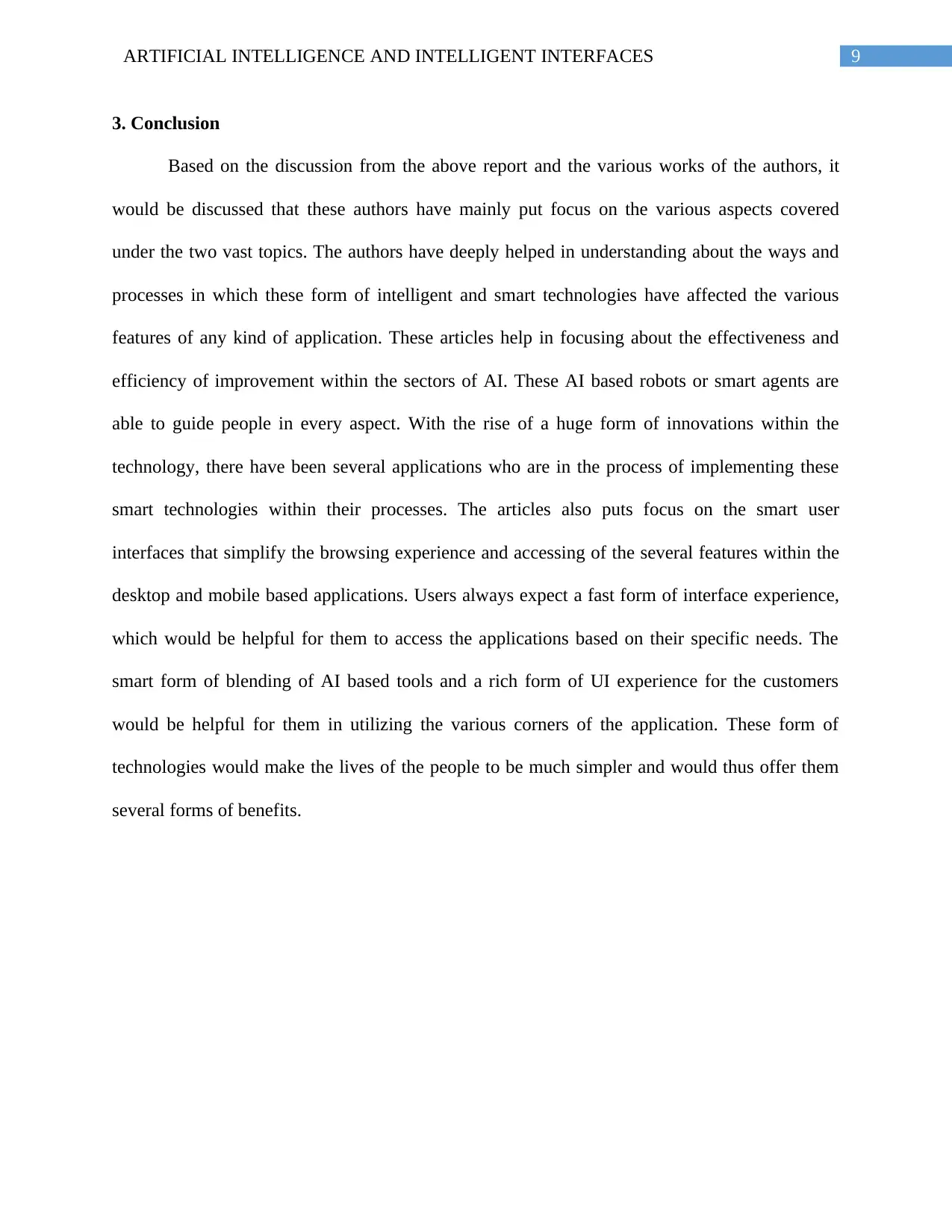
9ARTIFICIAL INTELLIGENCE AND INTELLIGENT INTERFACES
3. Conclusion
Based on the discussion from the above report and the various works of the authors, it
would be discussed that these authors have mainly put focus on the various aspects covered
under the two vast topics. The authors have deeply helped in understanding about the ways and
processes in which these form of intelligent and smart technologies have affected the various
features of any kind of application. These articles help in focusing about the effectiveness and
efficiency of improvement within the sectors of AI. These AI based robots or smart agents are
able to guide people in every aspect. With the rise of a huge form of innovations within the
technology, there have been several applications who are in the process of implementing these
smart technologies within their processes. The articles also puts focus on the smart user
interfaces that simplify the browsing experience and accessing of the several features within the
desktop and mobile based applications. Users always expect a fast form of interface experience,
which would be helpful for them to access the applications based on their specific needs. The
smart form of blending of AI based tools and a rich form of UI experience for the customers
would be helpful for them in utilizing the various corners of the application. These form of
technologies would make the lives of the people to be much simpler and would thus offer them
several forms of benefits.
3. Conclusion
Based on the discussion from the above report and the various works of the authors, it
would be discussed that these authors have mainly put focus on the various aspects covered
under the two vast topics. The authors have deeply helped in understanding about the ways and
processes in which these form of intelligent and smart technologies have affected the various
features of any kind of application. These articles help in focusing about the effectiveness and
efficiency of improvement within the sectors of AI. These AI based robots or smart agents are
able to guide people in every aspect. With the rise of a huge form of innovations within the
technology, there have been several applications who are in the process of implementing these
smart technologies within their processes. The articles also puts focus on the smart user
interfaces that simplify the browsing experience and accessing of the several features within the
desktop and mobile based applications. Users always expect a fast form of interface experience,
which would be helpful for them to access the applications based on their specific needs. The
smart form of blending of AI based tools and a rich form of UI experience for the customers
would be helpful for them in utilizing the various corners of the application. These form of
technologies would make the lives of the people to be much simpler and would thus offer them
several forms of benefits.
Paraphrase This Document
Need a fresh take? Get an instant paraphrase of this document with our AI Paraphraser
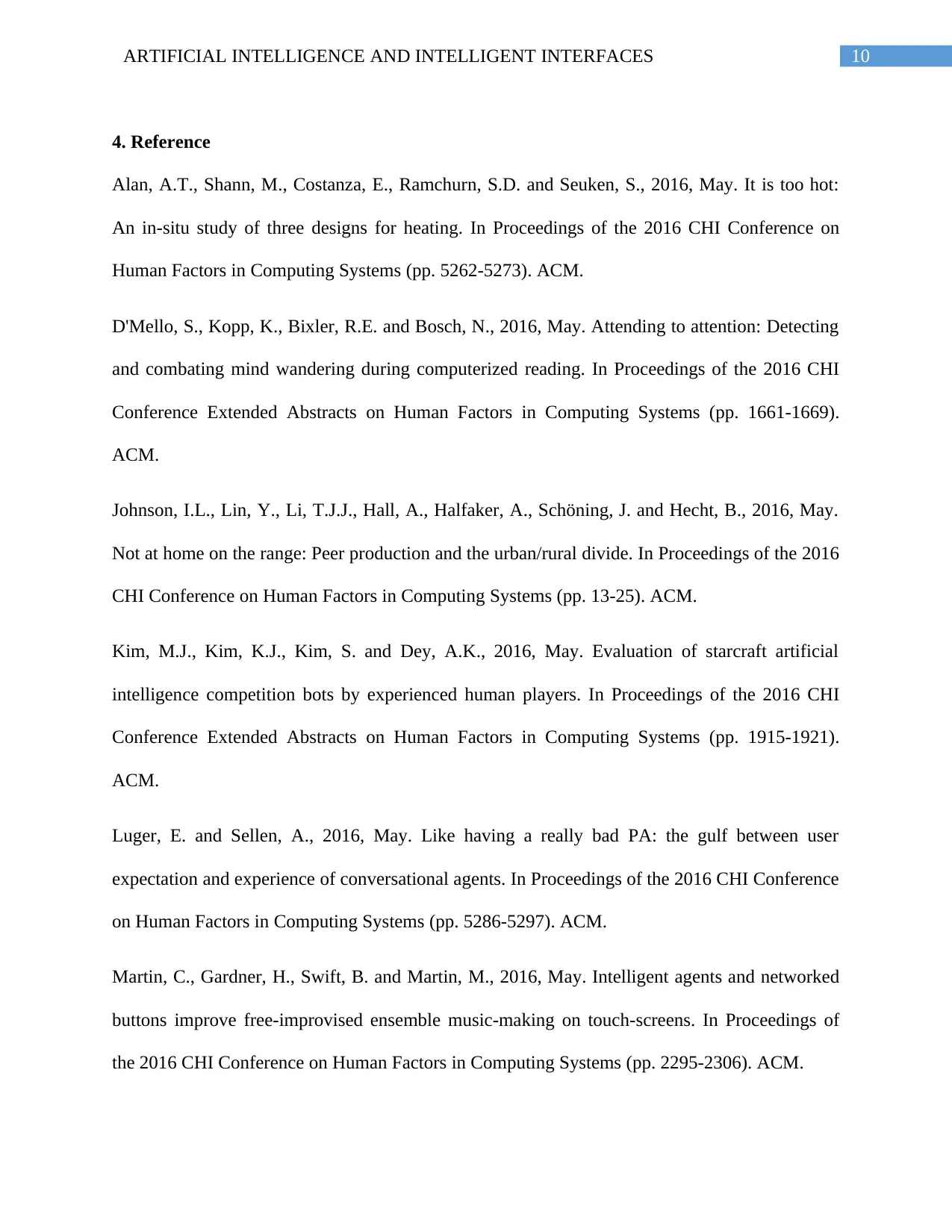
10ARTIFICIAL INTELLIGENCE AND INTELLIGENT INTERFACES
4. Reference
Alan, A.T., Shann, M., Costanza, E., Ramchurn, S.D. and Seuken, S., 2016, May. It is too hot:
An in-situ study of three designs for heating. In Proceedings of the 2016 CHI Conference on
Human Factors in Computing Systems (pp. 5262-5273). ACM.
D'Mello, S., Kopp, K., Bixler, R.E. and Bosch, N., 2016, May. Attending to attention: Detecting
and combating mind wandering during computerized reading. In Proceedings of the 2016 CHI
Conference Extended Abstracts on Human Factors in Computing Systems (pp. 1661-1669).
ACM.
Johnson, I.L., Lin, Y., Li, T.J.J., Hall, A., Halfaker, A., Schöning, J. and Hecht, B., 2016, May.
Not at home on the range: Peer production and the urban/rural divide. In Proceedings of the 2016
CHI Conference on Human Factors in Computing Systems (pp. 13-25). ACM.
Kim, M.J., Kim, K.J., Kim, S. and Dey, A.K., 2016, May. Evaluation of starcraft artificial
intelligence competition bots by experienced human players. In Proceedings of the 2016 CHI
Conference Extended Abstracts on Human Factors in Computing Systems (pp. 1915-1921).
ACM.
Luger, E. and Sellen, A., 2016, May. Like having a really bad PA: the gulf between user
expectation and experience of conversational agents. In Proceedings of the 2016 CHI Conference
on Human Factors in Computing Systems (pp. 5286-5297). ACM.
Martin, C., Gardner, H., Swift, B. and Martin, M., 2016, May. Intelligent agents and networked
buttons improve free-improvised ensemble music-making on touch-screens. In Proceedings of
the 2016 CHI Conference on Human Factors in Computing Systems (pp. 2295-2306). ACM.
4. Reference
Alan, A.T., Shann, M., Costanza, E., Ramchurn, S.D. and Seuken, S., 2016, May. It is too hot:
An in-situ study of three designs for heating. In Proceedings of the 2016 CHI Conference on
Human Factors in Computing Systems (pp. 5262-5273). ACM.
D'Mello, S., Kopp, K., Bixler, R.E. and Bosch, N., 2016, May. Attending to attention: Detecting
and combating mind wandering during computerized reading. In Proceedings of the 2016 CHI
Conference Extended Abstracts on Human Factors in Computing Systems (pp. 1661-1669).
ACM.
Johnson, I.L., Lin, Y., Li, T.J.J., Hall, A., Halfaker, A., Schöning, J. and Hecht, B., 2016, May.
Not at home on the range: Peer production and the urban/rural divide. In Proceedings of the 2016
CHI Conference on Human Factors in Computing Systems (pp. 13-25). ACM.
Kim, M.J., Kim, K.J., Kim, S. and Dey, A.K., 2016, May. Evaluation of starcraft artificial
intelligence competition bots by experienced human players. In Proceedings of the 2016 CHI
Conference Extended Abstracts on Human Factors in Computing Systems (pp. 1915-1921).
ACM.
Luger, E. and Sellen, A., 2016, May. Like having a really bad PA: the gulf between user
expectation and experience of conversational agents. In Proceedings of the 2016 CHI Conference
on Human Factors in Computing Systems (pp. 5286-5297). ACM.
Martin, C., Gardner, H., Swift, B. and Martin, M., 2016, May. Intelligent agents and networked
buttons improve free-improvised ensemble music-making on touch-screens. In Proceedings of
the 2016 CHI Conference on Human Factors in Computing Systems (pp. 2295-2306). ACM.
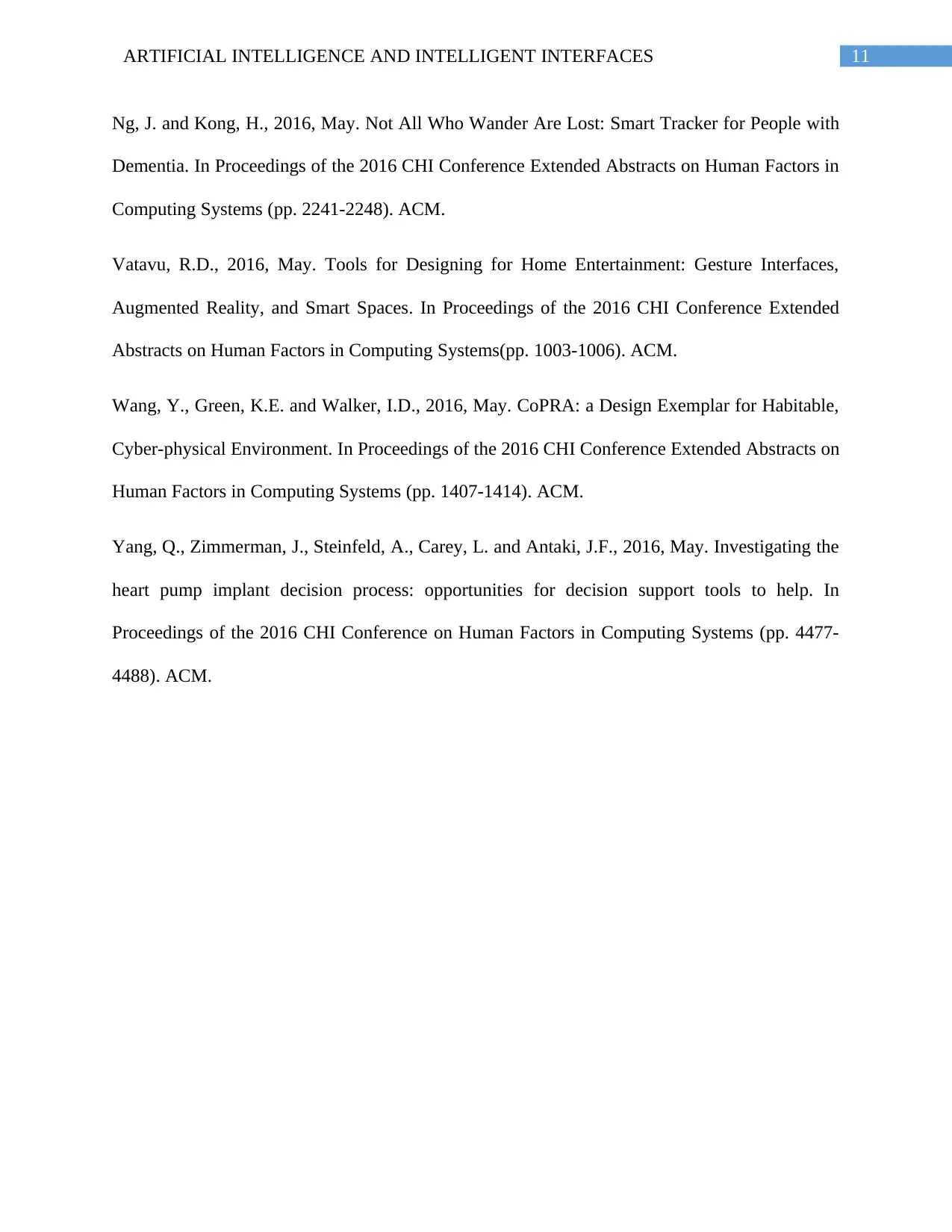
11ARTIFICIAL INTELLIGENCE AND INTELLIGENT INTERFACES
Ng, J. and Kong, H., 2016, May. Not All Who Wander Are Lost: Smart Tracker for People with
Dementia. In Proceedings of the 2016 CHI Conference Extended Abstracts on Human Factors in
Computing Systems (pp. 2241-2248). ACM.
Vatavu, R.D., 2016, May. Tools for Designing for Home Entertainment: Gesture Interfaces,
Augmented Reality, and Smart Spaces. In Proceedings of the 2016 CHI Conference Extended
Abstracts on Human Factors in Computing Systems(pp. 1003-1006). ACM.
Wang, Y., Green, K.E. and Walker, I.D., 2016, May. CoPRA: a Design Exemplar for Habitable,
Cyber-physical Environment. In Proceedings of the 2016 CHI Conference Extended Abstracts on
Human Factors in Computing Systems (pp. 1407-1414). ACM.
Yang, Q., Zimmerman, J., Steinfeld, A., Carey, L. and Antaki, J.F., 2016, May. Investigating the
heart pump implant decision process: opportunities for decision support tools to help. In
Proceedings of the 2016 CHI Conference on Human Factors in Computing Systems (pp. 4477-
4488). ACM.
Ng, J. and Kong, H., 2016, May. Not All Who Wander Are Lost: Smart Tracker for People with
Dementia. In Proceedings of the 2016 CHI Conference Extended Abstracts on Human Factors in
Computing Systems (pp. 2241-2248). ACM.
Vatavu, R.D., 2016, May. Tools for Designing for Home Entertainment: Gesture Interfaces,
Augmented Reality, and Smart Spaces. In Proceedings of the 2016 CHI Conference Extended
Abstracts on Human Factors in Computing Systems(pp. 1003-1006). ACM.
Wang, Y., Green, K.E. and Walker, I.D., 2016, May. CoPRA: a Design Exemplar for Habitable,
Cyber-physical Environment. In Proceedings of the 2016 CHI Conference Extended Abstracts on
Human Factors in Computing Systems (pp. 1407-1414). ACM.
Yang, Q., Zimmerman, J., Steinfeld, A., Carey, L. and Antaki, J.F., 2016, May. Investigating the
heart pump implant decision process: opportunities for decision support tools to help. In
Proceedings of the 2016 CHI Conference on Human Factors in Computing Systems (pp. 4477-
4488). ACM.
⊘ This is a preview!⊘
Do you want full access?
Subscribe today to unlock all pages.

Trusted by 1+ million students worldwide
1 out of 12
Related Documents
Your All-in-One AI-Powered Toolkit for Academic Success.
+13062052269
info@desklib.com
Available 24*7 on WhatsApp / Email
![[object Object]](/_next/static/media/star-bottom.7253800d.svg)
Unlock your academic potential
Copyright © 2020–2025 A2Z Services. All Rights Reserved. Developed and managed by ZUCOL.




